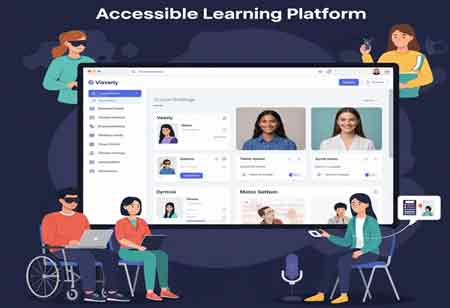THANK YOU FOR SUBSCRIBING
Be first to read the latest tech news, Industry Leader's Insights, and CIO interviews of medium and large enterprises exclusively from Education Technology Insights
Designing Platforms That Make Education Truly Accessible
Accessible learning platforms are essential for individuals with disabilities, guided by WCAG 2.1 principles to ensure education is inclusive, user-friendly, and compatible with assistive technologies.

By
Education Technology Insights | Monday, November 10, 2025
Stay ahead of the industry with exclusive feature stories on the top companies, expert insights and the latest news delivered straight to your inbox. Subscribe today.
Fremont, CA: In today’s digital age, education is more accessible than ever before. Yet, many individuals with disabilities continue to face significant barriers that limit their ability to learn effectively. Truly accessible learning platforms are not just beneficial, but essential. Education must be treated as a fundamental right for all, not a privilege reserved for a few.
Core Principles of Accessible Platform Design
Designing for accessibility is not about creating separate or isolated experiences, but rather about developing a robust and adaptable digital environment that inherently supports a wide range of user needs. Central to this approach are the Web Content Accessibility Guidelines (WCAG) 2.1, established by the World Wide Web Consortium (W3C). These guidelines provide a globally recognized framework grounded in four fundamental principles: perceivable, operable, understandable, and robust.
A perceivable interface ensures that information and user interface components are presented in a way that users can effectively perceive and understand. This includes offering text alternatives for non-text content—such as image descriptions and video captions—along with adaptable features like adjustable text size and sufficient color contrast. It also involves ensuring clarity in auditory elements by distinguishing foreground sounds from background noise.
An operable interface allows users to navigate and interact with all functionality through various means, including keyboard access. It ensures that users have adequate time to read and interact with content, avoids triggering content (e.g., flashing elements that may cause seizures), and promotes consistent and intuitive navigation.
For an interface to be understandable, both the content and its operation must be transparent and predictable. This involves using plain language, maintaining consistent layout and behavior across pages, and providing guidance to help users identify, avoid, and correct errors.
A robust interface must be compatible with a wide array of user agents, including assistive technologies. This is achieved by writing clean, valid code and ensuring that digital content remains functional as technologies evolve.
Key Considerations and Practical Implementations
The design of a user interface (UI) and user experience (UX) should be based on principles of accessibility. This includes a clear and consistent layout, color contrast, font readability, keyboard navigation, focus management, content accessibility, form labels, error identification, accessible controls, assistive technology compatibility, screen reader testing, and speech recognition software. The layout should be simple, predictable, and provide ample white space. Content should have accurate captions and transcripts, audio descriptions, and structured content. Forms and interactive elements should have clear labels and error messages that are easily visible and understandable. Accessible controls should be keyboard operable and provide appropriate ARIA attributes. Assistive technology compatibility should be ensured through the use of ARIA attributes, thorough screen reader testing, and compatibility with speech recognition software. User feedback and testing should involve users with disabilities and should conduct regular accessibility audits. Equally important is the provision of clear channels for reporting accessibility issues, as this encourages user participation and facilitates continuous improvement.
Designing accessible learning platforms is not just about meeting legal requirements; it's about upholding the fundamental right to education for every individual. The journey towards truly accessible learning is ongoing, but with dedication and a user-centered approach, it helps in building platforms that unlock the full potential of every learner.







